The Cordilleras are a unique blend of biodiversity and cultural heritage.
This region is home to towering peaks and diverse habitats that host endemic species. For example, the Resplendent Quetzal and Jaguar inhabit this region, along with vibrant orchids.
Indigenous communities, such as the Bribri and Cabécar, have lived in harmony with the landscape, practicing sustainable agriculture and traditional crafts.
These communities have woven their rich traditions into the landscape. However, the region faces threats from climate change and habitat loss.
By embracing responsible tourism and conservation, individuals can help preserve this remarkable region's legacy.
Geographic Overview
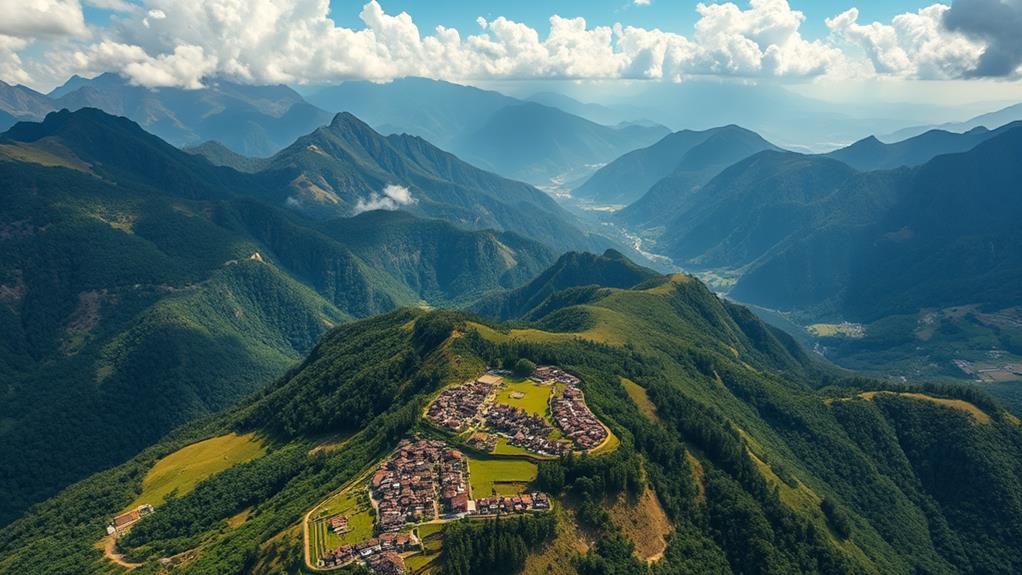
Cordillera de Talamanca: A Diverse and Isolated Mountain Range
The Cordillera de Talamanca mountain range stretches across southern Costa Rica and western Panama, serving as a natural barrier between the central highlands and coastal lowlands.
This range boasts elevations from sea level to over 3,650 meters, with Mount Chirripó reaching a towering 3,819 meters.
The region consists of two parallel ranges: the rugged Interior Range and the lower Caribbean Range, separated by lush valleys and rivers.
These ranges support an extraordinary array of ecosystems, including tropical rainforests, cloud forests, and alpine grasslands.
The poor transportation infrastructure in the area has contributed to its isolation, which has enabled the development of unique and endemic species.
This isolation has created a haven for biodiversity, making the Cordillera de Talamanca a hub for nature enthusiasts and researchers.
Geological Formation
Geological Formation of the Cordillera de Talamanca
The Cordillera de Talamanca's stunning landscapes and rich biodiversity are the result of dramatic geological forces that shaped the mountain range over millions of years. Originating as volcanic islands, these mountains underwent tectonic uplift, isolating them from other parallel ranges.
This unique geological formation crafted a complex topography marked by rugged peaks and deep valleys, with elevations ranging from sea level to over 3,650 meters (12,000 feet).
Key Aspects of the Geological Phenomenon
Diverse Elevations support different habitats, enhancing biodiversity. For example, the varying elevations of the Cordillera de Talamanca support a range of ecosystems, from tropical rainforests to alpine grasslands.
Distinct Habitats are a result of the geological history. The unique geological formation contributes to a range of ecosystems, including cloud forests, tropical dry forests, and alpine grasslands.
Evolutionary Processes have driven unique species development. Isolation and geological changes have resulted in species found nowhere else, such as the resplendent quetzal and the harlequin frog, which are endemic to the region.
Understanding the geological formation of the Cordillera de Talamanca is crucial for grasping the evolution of its distinct habitats and recognizing the conservation challenges they face today.
Ecosystems and Climate
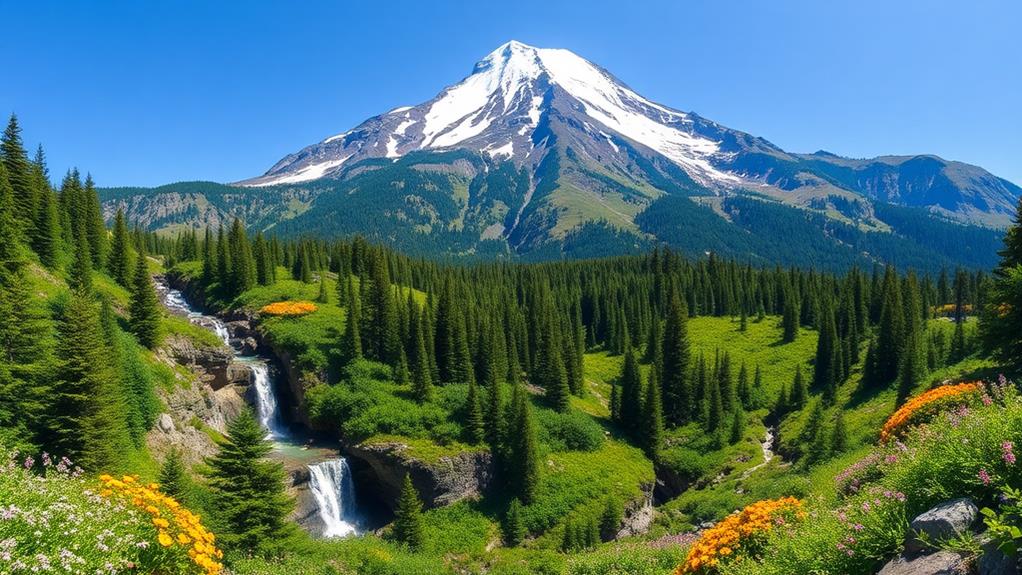
Ecosystems and Climate in the Cordillera de Talamanca
The Cordillera de Talamanca's diverse ecosystems interact with its unique climate to create rich biodiversity. Elevation and climate establish a range of habitats, from tropical rainforests to cloud forests and alpine grasslands. Each ecosystem supports a distinct array of flora and fauna, some of which are endemic and adapted to specific altitudinal zones.
As you move through these ecosystems, you'll notice the transition from humid rainforests to misty cloud forests, which fosters incredible biodiversity. This isn't just about plants; countless wildlife species thrive here, relying on these varied habitats for survival.
The high-altitude páramo, with its cold-adapted vegetation, showcases another facet of this rich tapestry of life.
These ecosystems are vital for regulating local climates and providing essential habitats that sustain the region's cultural heritage. By understanding the connection between ecosystems, climate, and biodiversity, you're helping to advocate for the preservation of this extraordinary landscape, ensuring that both its natural beauty and cultural significance endure for future generations.
Biodiversity Hotspot
The Cordillera de Talamanca is a recognized biodiversity hotspot, characterized by its exceptional variety of life. This region's unique ecosystems support an incredible array of species, many of which are endemic to the area.
The diverse climatic conditions and altitudinal gradients create a rich tapestry of habitats, from lush tropical rainforests to alpine grasslands.
The region is home to an iconic avian diversity, exemplified by the Resplendent Quetzal, which thrives in the cloud forests. Large mammals, such as Baird's Tapir, Puma, and Jaguar, roam the dense forests, highlighting the area's significance for wildlife conservation.
The transition from humid rainforests to cold páramo habitats illustrates the remarkable biodiversity fostered by these varied ecosystems.
Conservation efforts are crucial in this region, as many species are rare and endangered. Protecting this hotspot isn't just about preserving biodiversity; it's about safeguarding the ecological integrity of the entire region.
The Cordillera de Talamanca's designation as a UNESCO World Heritage site emphasizes its global importance, urging us all to advocate for the preservation of its unique ecological and cultural heritage.
Endemic Species

The Cordillera de Talamanca is home to a remarkable array of endemic species found nowhere else on Earth.
This region boasts an impressive biodiversity, with many plants and animals thriving in its diverse cloud forests. For example, the Resplendent Quetzal and the Black-faced Solitaire are two remarkable birds that can be found here. The region is also home to unique flora, such as the Chirripó lily and various orchids, which have adapted to the specific climatic conditions.
The isolation of these ecosystems has led to the evolution of these unique species.
The tectonic uplift of the region has created isolated ecosystems, which have spurred the evolution of species closely related to those in the Andes. This high level of endemism is a testament to the region's ecological significance.
These endemic species face significant threats.
Habitat loss and climate change pose significant threats to the survival of these endemic species.
Conservation is crucial to protect these species.
Protecting the Talamanca Range-La Amistad Reserves is vital for their survival. By supporting conservation efforts, we can safeguard the extraordinary biodiversity of the Cordillera de Talamanca and ensure that future generations can experience the beauty and uniqueness of these endemic species.
Conservation Efforts
Conservation Efforts in the Cordillera de Talamanca
Protecting the Cordillera de Talamanca's breathtaking biodiversity requires collaborative conservation efforts. These initiatives not only safeguard the area's rich ecosystems but also involve local indigenous communities in meaningful ways.
Community Involvement
Engaging indigenous groups, such as the Bribri and Cabécar, is crucial for sustainable land use practices. Their generations-honed practices enhance biodiversity while respecting cultural traditions.
By working together, conservationists can learn from and build upon the indigenous communities' knowledge, ensuring a more effective and culturally sensitive approach to conservation.
Transboundary Collaboration
The Cordillera de Talamanca extends into Panama, making international cooperation vital for preserving shared ecosystems. Collaborative projects can help combat challenges like deforestation and habitat loss more effectively.
For instance, joint conservation efforts can facilitate the sharing of resources, expertise, and knowledge, leading to a more comprehensive approach to protecting the region's biodiversity.
Research and Monitoring
Ongoing studies are crucial to assess biodiversity and the impacts of climate change. These studies provide valuable data that supports the development of effective conservation strategies tailored to the region's unique needs.
Cultural Heritage
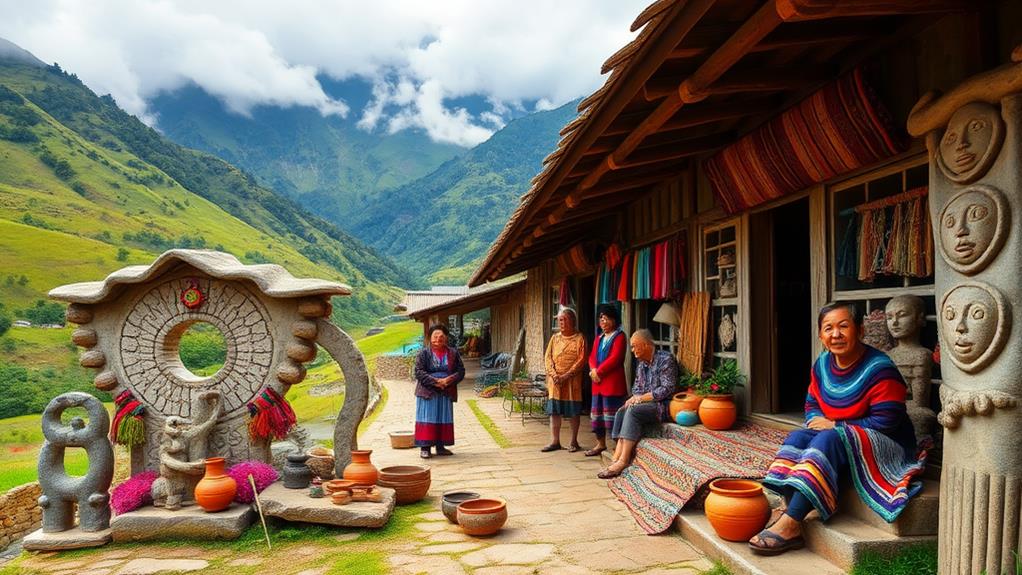
Cultural Heritage in the Cordillera de Talamanca
The Cordillera de Talamanca region is home to the rich cultural heritage of its indigenous communities, particularly the Bribri and Cabécar. These groups maintain traditional lifestyles that not only sustain their identity but also embody the cultural significance of the region.
Cultural Elements and Their Significance
Four key cultural elements stand out: traditional crafts, languages, agricultural practices, and land rights.
Traditional Crafts
These crafts reflect ancestral skills and stories. For example, the Bribri people are known for their expertise in weaving baskets from palm leaves, a skill passed down through generations.
Languages
The languages spoken by the Bribri and Cabécar preserve histories and worldviews. The Bribri language, for instance, contains stories and legends that have been shared orally for centuries.
Agricultural Practices
The traditional agricultural practices of shifting cultivation and native crop cultivation promote sustainability and biodiversity. These practices have allowed the indigenous communities to thrive in the region for centuries.
Land Rights
The indigenous communities' land rights uphold ancestral territories and identity. The Bribri and Cabécar people have a deep connection to the land, which is essential to their cultural heritage.
Cultural Tourism and Exchange
Cultural tourism in the Cordillera de Talamanca region provides an opportunity for visitors to engage with this rich heritage. By participating in cultural tourism, visitors support local economies and promote cultural exchange.
This exchange not only honors the legacy of the indigenous communities but also champions the preservation of their unique cultural heritage.
Indigenous Communities
In the Talamanca region of southern Costa Rica, indigenous communities like the Bribri and Cabécar thrive, deeply intertwined with the area's rich ecosystems. These groups embody the essence of cultural heritage, maintaining their traditional lifestyles while advocating for biodiversity preservation. Their practices showcase a harmonious relationship with nature, vital for sustaining the environment.
Sustainable Agriculture is a key aspect of these indigenous communities. They cultivate crops like cacao and coffee, which aren't only central to their diets but also integral to their economic well-being and cultural identity.
For example, cacao is used in ceremonies and coffee is traded with neighboring communities.
Cultural Practices are unique to each community. The Bribri people have a distinct language and craft traditional pottery, while the Cabécar people are known for their expertise in natural medicine.
These customs enrich the cultural tapestry of the Cordillera and promote biodiversity.
Environmental Advocacy is essential to these indigenous groups. Many stress the importance of land rights and environmental protection, ensuring their ancestral territories are safeguarded for future generations.
For instance, the Bribri people have established their own protected areas to conserve the region's rich biodiversity.
Economic Significance
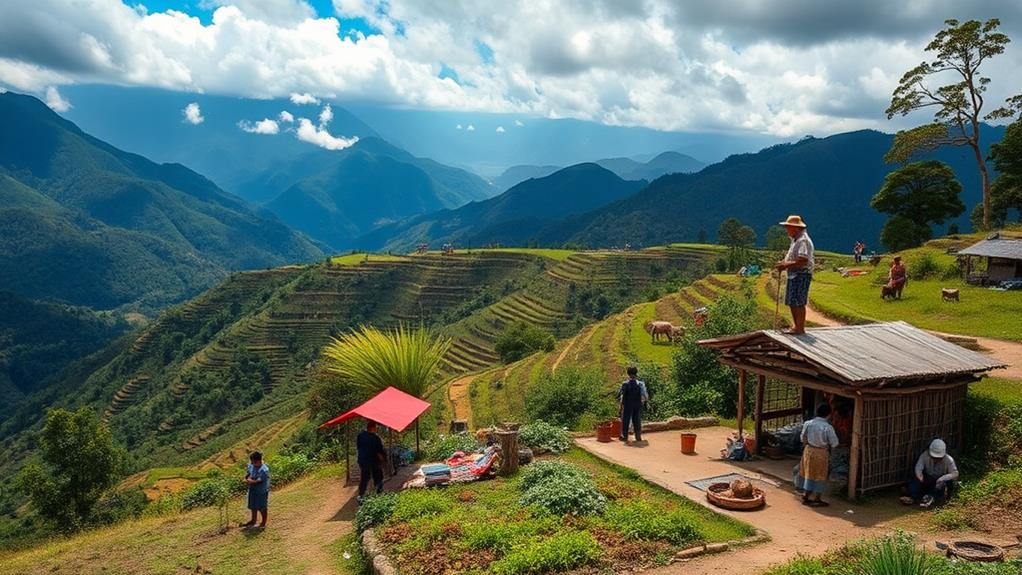
The Cordilleras' Economic Significance
The Cordilleras' economic significance is deeply rooted in the cultural practices of indigenous communities. Agriculture, mining, and traditional crafts are the mainstay of local economies, thanks to the region's rich biodiversity and natural resources.
Fertile valleys support sustainable farming, which not only produces food but also provides a livelihood for numerous families.
Eco-tourism is a crucial revenue generator, attracting visitors who want to experience the region's breathtaking landscapes and cultural heritage. This influx of tourists promotes conservation efforts and sustainable development.
As a result, local crafts and cultural industries thrive, preserving traditions while boosting the economy.
Infrastructure development is vital for connecting communities and facilitating trade.
Improved roads and transportation networks enhance opportunities for local businesses, ensuring the rich cultural tapestry of the Cordilleras continues to flourish.
Supporting these economic activities is essential for valuing the region's unique biodiversity and cultural heritage.
Tourism and Recreation
Discover the Cordilleras' Natural Beauty and Rich Cultural Heritage
The Cordilleras offer an unforgettable experience, combining stunning natural landscapes with a rich cultural heritage. As an eco-tourism haven, this region allows you to connect with both its remarkable biodiversity and local culture. From trekking through lush green rice terraces to visiting age-old villages, the Cordilleras provide a unique opportunity to immerse yourself in traditional practices and customs. The sacred mountain myths, passed down through generations, add a mystical allure to the area, inviting visitors to delve deeper into the spiritual beliefs of the local communities. Whether you are seeking adventure or seeking to learn more about indigenous traditions, the Cordilleras is truly a place where nature and culture intertwine.
Immerse in Nature with Outdoor Adventures
The Cordilleras provide a range of outdoor activities to explore its natural beauty. Hiking in Chirripó National Park allows you to climb to the summit of Mount Chirripó, Costa Rica's highest peak, and witness diverse ecosystems, from tropical rainforests to alpine grasslands.
Additionally, you can experience adventure activities like zip-lining through the canopy, mountain biking on rugged trails, or white-water rafting in pristine rivers, all while enjoying the region's spectacular landscapes.
Engage with Indigenous Communities
The Cordilleras are home to indigenous communities like the Bribri and Cabécar. Cultural interactions enable you to learn about their traditional lifestyles, crafts, and agricultural practices, enriching your travel experience while supporting cultural heritage preservation.
Conservation Efforts
The Cordilleras prioritize conservation, ensuring the protection of both biodiversity and cultural heritage for future generations.
Environmental Challenges
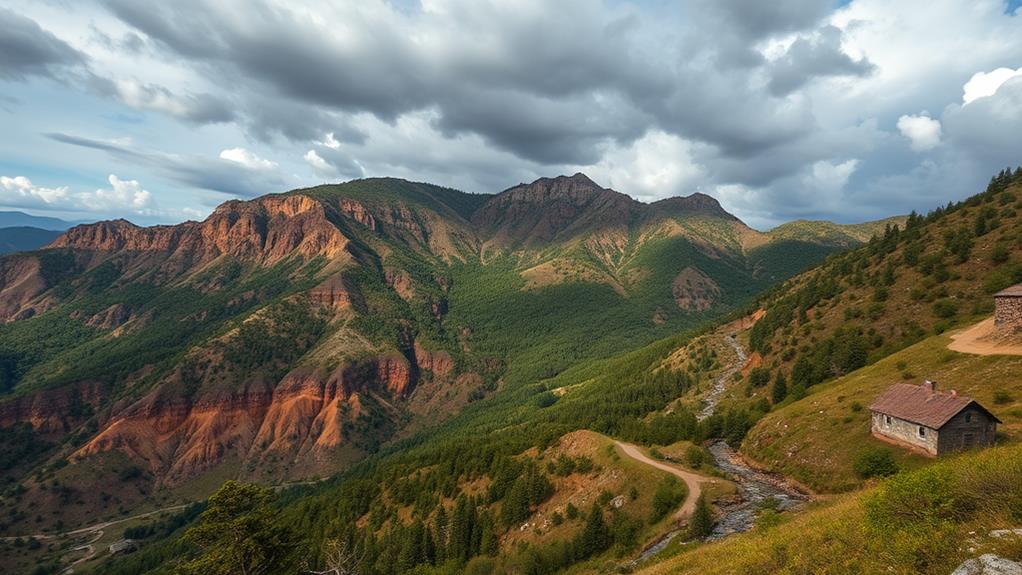
The Cordilleras' ecosystems are threatened by significant environmental challenges.
The region's rich biodiversity and unique species are at risk due to deforestation, which is a major threat to the ecosystem.
Climate change also poses a significant risk, bringing increased temperatures and unpredictable rain patterns that make it difficult for delicate habitats to adapt.
Understanding the Environmental Challenges
The Cordilleras face four significant environmental challenges:
Deforestation leads to loss of biodiversity and habitat destruction.
Climate change increases the vulnerability of species.
Habitat fragmentation limits wildlife movement and genetic diversity, while unsustainable practices undermine conservation efforts.
The Impact of Habitat Fragmentation
Habitat fragmentation, caused by agriculture, urbanization, and infrastructure development, severely limits wildlife movement, which is essential for maintaining genetic diversity.
For example, the fragmentation of habitats has divided the range of the Philippine eagle, making it difficult for the species to find food and mates.
Addressing the Challenges
To address these challenges, it's essential to integrate indigenous knowledge and traditional practices to promote sustainable resource management.
This can be achieved by working with local communities to develop sustainable land use practices and protecting areas from illegal logging and habitat destruction.
Future of the Cordilleras
The future of the Cordilleras depends on collaborative efforts to protect its rich biodiversity and cultural heritage.
Three key areas of focus are crucial for achieving this goal:
Sustainable Land Use: Preserving habitats and strengthening ecosystem resilience against climate change require adopting practices that mitigate deforestation.
For instance, reforestation programs and sustainable forest management can help maintain the region's ecological balance.
Empowering Indigenous Communities: Indigenous communities possess invaluable ecological knowledge that can guide effective conservation efforts.
Their involvement ensures culturally relevant and sustainable strategies, as seen in community-led conservation initiatives that prioritize traditional practices and knowledge.
Promoting Ecotourism: Developing ecotourism creates financial incentives for locals to engage in conservation, fostering a direct link between economic benefits and the preservation of their cultural heritage.
This approach supports local livelihoods while promoting responsible travel practices.
International cooperation is also vital for safeguarding the interconnected ecosystems of the Cordilleras.
Transboundary conservation initiatives can protect these ecosystems, ensuring the region's biodiversity and cultural heritage thrive for generations to come.
Questions and Answers
What Is the Difference Between a Mountain Range and a Cordillera?
A mountain range is a series of connected peaks, whereas a cordillera is a group of parallel mountain ranges. This difference in structure has significant ecological implications.
Cordilleras, with their multiple parallel ranges, host a greater variety of habitats and species. For example, the Andes cordillera in South America is home to diverse ecosystems, including tropical rainforests, deserts, and glaciers, which support a wide range of plant and animal species.
Cordilleras also support richer cultural diversity, as various communities often thrive in these interconnected areas. The Himalayan cordillera, for instance, is home to numerous ethnic groups, each with their unique culture, language, and traditions.
In contrast, mountain ranges tend to have more homogeneous ecosystems and cultural influences.
What Are the Two Mountain Ranges That Form a Cordillera in the United States?
The Rocky Mountains and the Sierra Nevada form a cordillera in the United States.
These two mountain ranges are geologically significant because they shape the landscape and influence weather patterns. For example, the Rocky Mountains stretch over 3,000 miles from British Columbia, Canada, to New Mexico, USA, creating diverse weather patterns and ecosystems.
Both ranges boast remarkable ecological diversity, such as alpine tundra and vast forests. The Rocky Mountains are home to over 1,000 alpine lakes, while the Sierra Nevada is known for its giant sequoia groves.
These mountain ranges have been vital to indigenous cultures, offering resources and sacred sites. For instance, the Sierra Nevada has been home to the Paiute and Miwok tribes for centuries, providing them with natural resources and spiritual inspiration.
Exploring these mountains allows us to appreciate their natural beauty and cultural heritage.
What Are the Mountain Ranges That Are Collectively Known as the Western Cordillera?
The Western Cordillera consists of two primary mountain ranges: the Rocky Mountains and the Sierra Nevada.
These mountain ranges are rich in diverse ecosystems, supporting a wide variety of wildlife and plant species.
The Rocky Mountains, for example, are home to over 1,000 species of flowering plants and 300 species of birds.
Similarly, the Sierra Nevada range is known for its giant sequoia groves and diverse coniferous forests.
These mountain ranges also hold significant cultural importance, having been inhabited by indigenous communities for centuries.
The indigenous peoples of the region, such as the Ute and Paiute tribes, have developed unique practices and traditions that are closely tied to the land.
What Is the Meaning of Cordillera Mountains?
Cordillera mountains are systems of parallel mountain ranges that shape our planet's ecosystems. These mountain ranges are characterized by their unique parallel structure, which creates a variety of climates and habitats that support an incredible range of plant and animal species.
Cordillera ecosystems harbor incredible biodiversity. For example, the Andes mountain range in South America is home to over 45,000 plant species, many of which are found nowhere else on Earth. Additionally, cordillera ecosystems provide habitat for a wide range of animal species, such as the Andean condor, the spectacled bear, and the mountain tapir.
Cordillera ecosystems are often home to indigenous cultures. Many indigenous communities have lived in harmony with their cordillera environments for thousands of years, developing unique cultures and ways of life that are closely tied to the natural environment.
For example, the Quechua people of the Andes have developed a rich cultural heritage that's deeply connected to the land and its resources.
Cordillera ecosystems face significant conservation challenges. Climate change is a major threat, as it alters the delicate balance of these ecosystems and can lead to the loss of habitat and extinction of species.
Habitat loss and fragmentation are also major concerns, as human activities such as mining, logging, and agriculture can lead to the destruction and degradation of cordillera ecosystems.